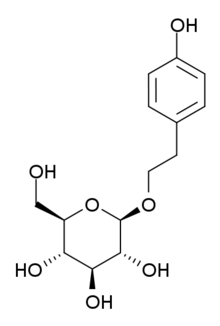Salidroside
 | |
| Names | |
|---|---|
| IUPAC name
2-(4-hydroxyphenyl)ethyl β-D-glucopyranoside | |
| Other names
Salidroside Rhodioloside (2R,3S,4S,5R,6R)-2-(hydroxymethyl)-6-[2-(4-hydroxyphenyl)ethoxy]oxane-3,4,5-triol Tyrosol glucoside | |
| Identifiers | |
| 10338-51-9 | |
| 3D model (Jmol) | Interactive image |
| ChEMBL | ChEMBL465208 |
| ChemSpider | 140088 |
| ECHA InfoCard | 100.224.258 |
| PubChem | 159278 |
| UNII | M983H6N1S9 |
| |
| |
| Properties | |
| C14H20O7 | |
| Molar mass | 300.304 g/mol |
| Except where otherwise noted, data are given for materials in their standard state (at 25 °C [77 °F], 100 kPa). | |
| | |
| Infobox references | |
Salidroside (Rhodioloside) is a glucoside of tyrosol found in the plant Rhodiola rosea. It is thought to be one of the compounds responsible for the antidepressant and anxiolytic actions of this plant, along with rosavin.[1][2] Salidroside may be more active than rosavin,[3] even though many commercially marketed Rhodiola rosea extracts are standardised for rosavin content rather than salidroside.
References
- ↑ Perfumi M, Mattioli L. Adaptogenic and central nervous system effects of single doses of 3% rosavin and 1% salidroside Rhodiola rosea L. extract in mice. Phytotherapy Research. 2007 Jan;21(1):37-43. doi:10.1002/ptr.2013 PMID 17072830
- ↑ Mattioli L, Funari C, Perfumi M. Effects of Rhodiola rosea L. extract on behavioural and physiological alterations induced by chronic mild stress in female rats. Journal of Psychopharmacology. 2008 May 30. doi:10.1177/0269881108089872 PMID 18515456
- ↑ Panossian A, Nikoyan N, Ohanyan N, Hovhannisyan A, Abrahamyan H, Gabrielyan E, Wikman G. Comparative study of Rhodiola preparations on behavioral despair of rats. Phytomedicine. 2008 Jan;15(1-2):84-91. doi:10.1016/j.phymed.2007.10.003 PMID 18054474
This article is issued from Wikipedia - version of the 9/23/2016. The text is available under the Creative Commons Attribution/Share Alike but additional terms may apply for the media files.